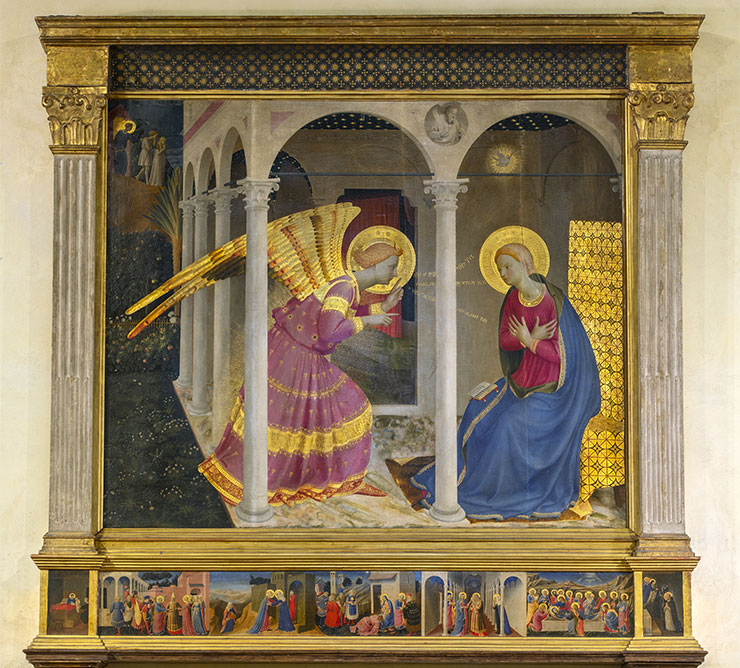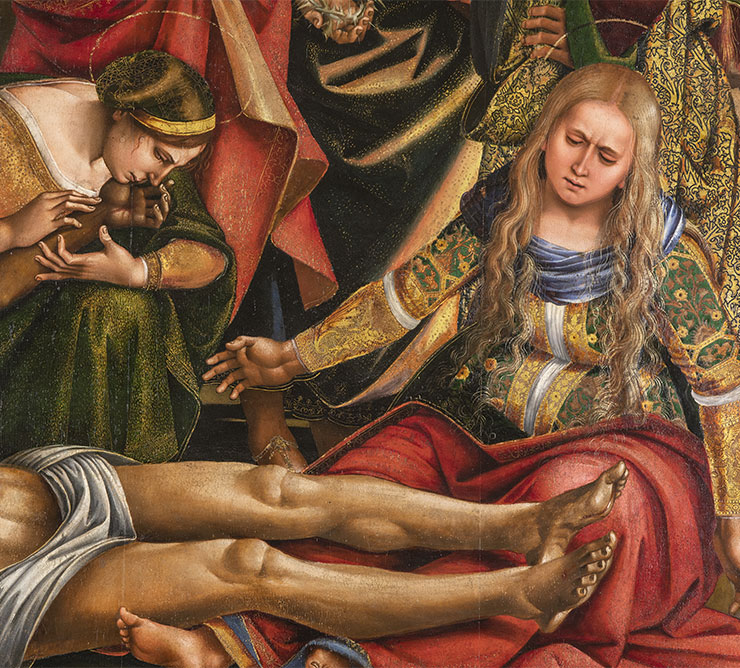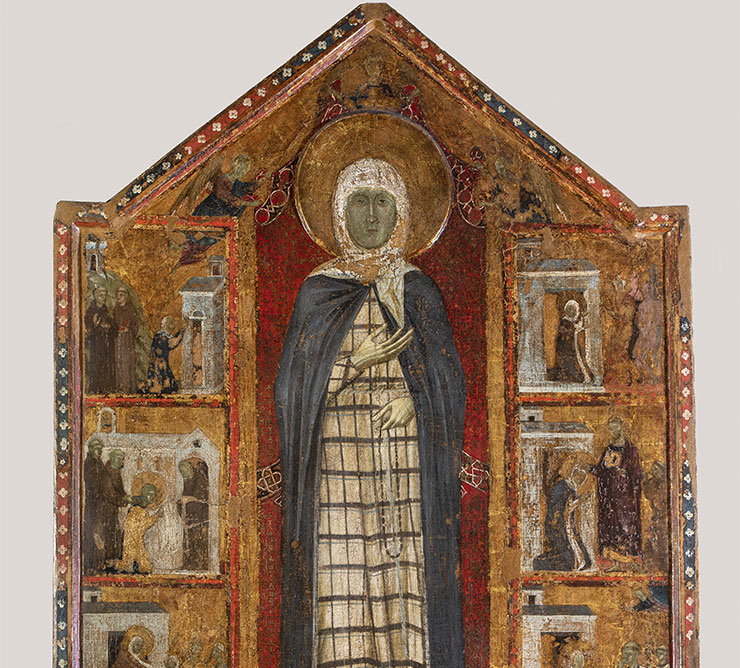Nella sua forma odierna, il Duomo fu progettata dai seguaci di Giuliano da Sangallo nella seconda metà del secolo XV inglobando la primitiva chiesa, come rivelano gli antichi frammenti visibili sulla facciata in pietre conce. In questo luogo sorgeva, infatti, la pieve di Santa Maria Assunta, documentata già nel 1068, ma secondo la tradizione edificata su un luogo di culto paleocristiano.
Il Museo Diocesano venne inaugurato nel 1945 per volontà del vescovo Giuseppe Franciolini e del Capitolo della Cattedrale dopo oltre vent’anni d’interventi. Già nel 1923, in occasione del quarto centenario della morte di Luca Signorelli, vi erano state adeguatamente sistemate le opere del grande maestro cortonese e, nel 1939, la raccolta era stata arricchita con alcune opere provenienti dalla Cattedrale e dalle chiese della Diocesi.
All’interno del Duomo è conservato un ricco patrimonio storico-artistico e devozionale. Ricordiamo, in particolare, il celebre quadro di Pietro da Cortona con la Natività, il ciborio di marmo attribuito allo scultore locale Ciuc... more
All’interno del Duomo è conservato un ricco patrimonio storico-artistico e devozionale. Ricordiamo, in particolare, il celebre quadro di Pietro da Cortona con la Natività, il ciborio di marmo attribuito allo scultore locale Ciuccio di Nuccio e un mosaico del cortonese Gino Severini raffigurante il Sacro Cuore.
Il Museo Diocesano raccoglie al suo interno dipinti su tavola e tela di straordinaria bellezza, insieme ad arredi liturgici, reliquiari e paramenti sacri di raffinata manifattura, testimonianza di arte e di fede di un’antichissima e altrettanto fiorente Comunità. Ricordiamo, in particolare, l’Annunciazione del Beato Angelico, la Deposizione del Signorelli, la Maestà e la grande Croce dipinta di Pietro Lorenzetti, l’Assunta di Bartolomeo della Gatta, il Reliquiario Vagnucci e il Parato Passerini, realizzato su disegni di Raffaellino del Garbo e Andrea del Sarto.
lessDUOMO:
MUSEO DIOCESANO:
(ultimo ingresso 30 minuti prima della chiusura)
In auto:
Sia da Nord che da Sud, uscire dall’autostrada del Sole (A1) al casello Valdichiana. Subito dopo l’uscita, prendere la superstrada E45 (Raccordo Siena-Perugia) in direzione Perugia e uscire alla seconda uscita per Cortona (Cortona San Lorenzo). Da qui, seguire le indicazioni in modo da arrivare alla SS71 in località Camucia e proseguire per Cortona.
In treno:
Con la Linea Ferroviaria Firenze/Roma, scendere alla Stazione di Terontola o Camucia. Con la Linea Ferroviaria Terontola Perugia Assisi Terni, scendere alla Stazione di Terontola. Da entrambe le Stazioni è facile raggiungere Cortona in taxi o autobus di linea. Per orari e tariffe dei treni visitate il sito delle Ferrovie dello Stato www.trenitalia.com

Considered among the highest masterpieces of the artist and of all Italian Renaissance painting, it is rightly regarded as the highlight of this museum's collection. For it is the most famous and most praised of the three works of the same subject painted by Fra Angelico that have been preserved. The work was commissioned by Giovanni di Cola di Cecco, a textile merchant and member of the Confraternity of St Domenico.
The sacred event represented in the painting takes place within an elegant portico, reminiscent of the architecture designed by Filippo Brunelleschi at the time, and offers depth to the entire work, allowing the painter to place the antecedent to the pivotal episode in the background. In the top left-hand corner are the Progenitors who, driven out of Eden, set out in despair towards the new suffering awaiting redemption, which will be accomplished by Mary, the 'new Eve'. The main scene presents the angel who, having just landed, with the usual stratagem of letters coming out of his mouth like a comic strip, brings the divine announcement. A veritable dialogue develops between the two characters with three verses marked in sequence, with Mary's reply in the middle, written upside down to make the direction of the sentence clear. Traits of finesse are evident throughout the composition: from the borders of the drapery to Mary's seat covered with a gold brocaded cloth, from the figure of Isaiah, prophet of the destiny of salvation, 'sculpted' within a tondo in the centre of the entablature, to the mixed marble floor. Seven scenes from the life of the Madonna are depicted on the predella. The landscape is a clear reference to Lake Trasimeno, which Angelico must surely have admired from the heights of Cortona.
less
The room exhibits an important collection of paintings made by Luca Signorelli with the collaboration of his atelier. Among these is the panel with the Lamentation over the Dead Christ, which the artist painted for the Sanctuary of Santa Margherita. The work, the oldest of Luca's works preserved in Cortona, was completed in 1502, as testified by an inscription along the frame, now missing.
An anecdote in Vasari's Lives recounts how Signorelli, "had a son whom he loved very much, and who was very handsome and a wonderful person, but yet who died, and Luca was so saddened that he portrayed him naked with great constancy of mind, without crying or shedding tears". The suggestive interpretation due to Vasari's story would have that the artist have reproduced here, in the lifeless corpse of Christ, the likeness of the firstborn who died during the plague epidemic that scourged Cortona in 1502. Completing the work, and defined by Vasari as "extremely rare", is the predella with episodes from the life of Jesus.
Vasari's anecdote from Lives relates how Signorelli, 'having been killed by a son whom he loved very much, beautiful in both face and person, Luca so grieved that he had him stripped naked and with great constancy of spirit without weeping or shedding a tear, portrayed him'. The suggestive interpretation due to Vasari's narration suggests that the artist here reproduced the likeness of the first-born son who died during the plague epidemic that scourged Cortona in 1502, in the bloodless corpse of Christ. Completing the work, still described by Vasari as 'extremely rare', is the predella with episodes from the life of Jesus.
less
Margaret was born in 1247 into a peasant family in Laviano, a small village between Montepulciano and Cortona. When she came of age, she eloped with a young nobleman from Montepulciano who never married her, not even after the birth of a son. Estranged from her relatives, she found hospitality in Cortona. Consecrated to penance and the care of the sick and the poor, she was received into the Franciscan Third Order.
Thanks to the support of wealthy families and the collaboration of some volunteers known as 'Poverelle', she founded the Hospital of Mercy in 1278. Dedicated to prayer and penance in a small cell in the Rocca above Cortona, Margaret actively intervened in the events of her own time to pacify souls and calm the turbulent political climate of her years. She died at the age of just fifty on 22 February 1297. The people immediately declared her a saint and wanted - in that same year - that a shrine be built on the spot where she had withdrawn in prayer. The panel exhibited here is probably one of the images painted immediately after her death, when the early fame of holiness attributed by popular veneration made the use of the halo tolerable even before canonisation. However, it took more than four centuries before the Church officially proclaimed her a saint in 1728 by Benedict XIII. Margaret thus became a glory of the Franciscan Order and the patron saint of Cortona, which for seven centuries has guarded her incorrupt body in the sanctuary dedicated to her. In the painting Margaret is portrayed as a young Tertiary with a checked robe covered by a dark mantle and a white veil on her head. Around the figure are depicted episodes from her life, narrated by her confessor Friar Giunta Bevegnati.
less